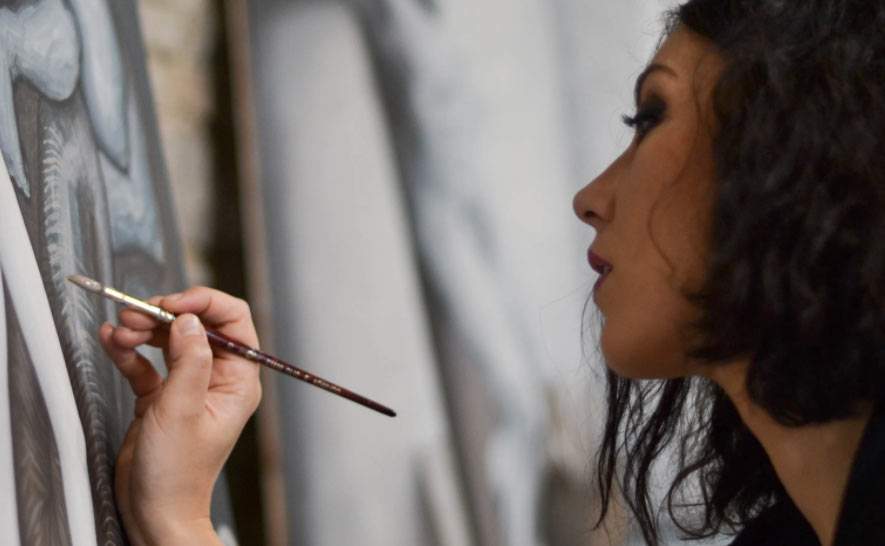A new online art gallery, featuring female artists, whose goals includesocial utility, which intends to break out of the capitalist mold of the contemporary art market and, as a result, target a wide audience with works with affordable prices: these are the foundations on which inWomen.Gallery was born, the project launched by 32-year-old Francesca Della Ventura, a contemporary art historian with international experience (she has worked in Italy, Spain, and Germany: she currently resides in Düsseldorf).
inWomen.Gallery proposes itself as a sustainable online gallery, with works accessible to a wide audience of buyers (in fact, the works will not have quotations above seven thousand euros), and a percentage of the sale that the gallery and the artists represented (who will be, as mentioned, exclusively women) commit to donate to an association that deals with the defense of women victims of violence: all designed for a public that does not follow the market and therefore wants to buy works of art without being conditioned by the dictates of trends, but simply because they love art. Underlying the decision to create an online gallery are not only the needs of the historical moment we live in, but also reflections on the awareness that the market is evolving and partly shifting to digital: this, according to the gallery, also means facing the challenges arising from these new dynamics, such as winning the trust of an audience that cannot see, at least at first, the work live.
“inWomen.Gallery,” says Francesca Della Ventura, “was born from the need to apply to the contemporary art system two concepts (until now hardly present art gallery world) that for me are fundamental: sustainability and gender equality. The contemporary art market is very often difficult to understand in its capitalist dynamics: it is a market that definitely privileges (white) men, in which women very often struggle to emerge. Of course the situation is changing, but not yet decisively. Here, inWomen.Gallery does not want to be a gallery that discriminates, but one that enhances. I am of the opinion (as one of the most important art critics of the post-World War II period, Lea Vergine, used to say) that art should be androgynous, not privileging any gender affiliation. The market, however, tells a different story. To get to this breaking down of gender differences, it is necessary, first, to give space to (and equalize) the gender that has suffered the most discrimination throughout art history (or history in general), which is the female gender. For me, this is an important step.” On the issue of sustainability, Della Ventura says, “the avenues are different, from supporting underrepresented artists, to conceiving an art collection that is stable over time and available to the community, to giving support to projects that improve our present and our future, to simply using wooden frames to have a reduced environmental impact.”
But how are women considered in the art world? “Women, not only in art (I talk about art because it is the field I know best and the one I work in),” says Francesca Della Ventura, “definitely start from a disadvantage. No man will be asked at a job interview if they plan to have children, no man has to hide a pregnancy, no man is judged by his physical appearance. Society almost considers artists to be nobodies, even worse if they are women. Historically speaking, women who have devoted themselves to artistic activities have always been considered outsiders. Let’s think about it: how many names of female artists do we know? At most if we remember any it is because they were described in textbooks as wives of, lovers of, muses of. None of them were accorded the dignity of the profession they were in. In my opinion it is necessary to go through a historical reconsideration of the role of women within art. In short, there would be a need to rewrite art history with more female names. Maybe someday the texts we have studied in school and university will be different and ample space will also be given to women who have invested their lives in art.”
This is certainly an ambitious project, not least because there will be more than just a sales dimension: inWomen.Gallery also wants to be a virtual cultural space where solo and group exhibitions will be organized, essays, articles and events will be shared, and great attention will be paid to contemporary female production. At the moment, the gallery represents four women artists (Giorgia Gigì, Carla Mura, Federica Scoppa and Francesca Maria D’Antonio) and several works can already be seen on the gallery’s website, https://inwomen.gallery. In short, an original project that declares itself open to all the female figures who populate the contemporary art system (curators, critics, consultants, dealers, gallery owners, scholars, researchers) and promises to be an experience of sure interest.
Pictured: Giorgia Gigì. Ph. Credit Elisabetta Damiani
 |
| InWomen.Gallery, a sustainable online gallery of only female artists, is born |
Warning: the translation into English of the original Italian article was created using automatic tools. We undertake to review all articles, but we do not guarantee the total absence of inaccuracies in the translation due to the program. You can find the original by clicking on the ITA button. If you find any mistake,please contact us.